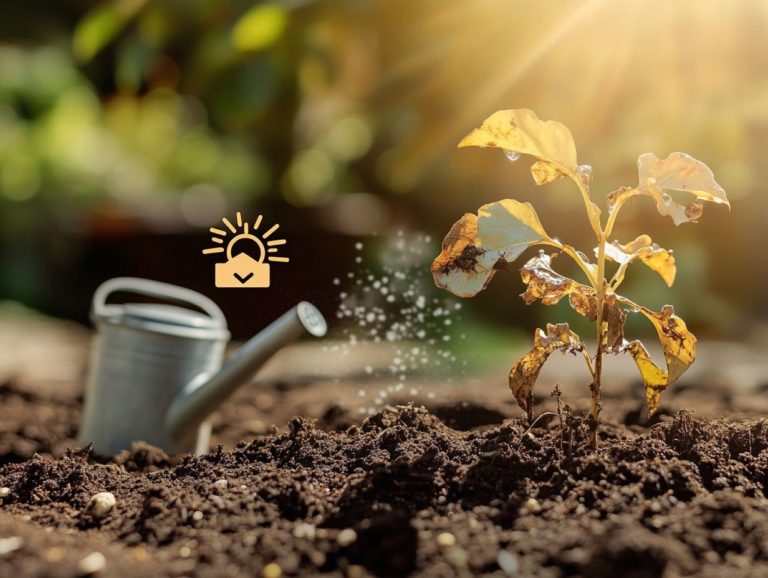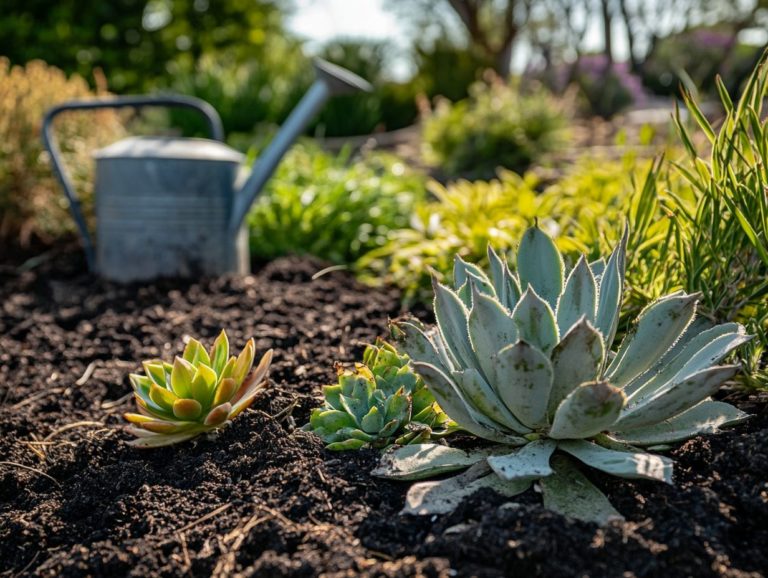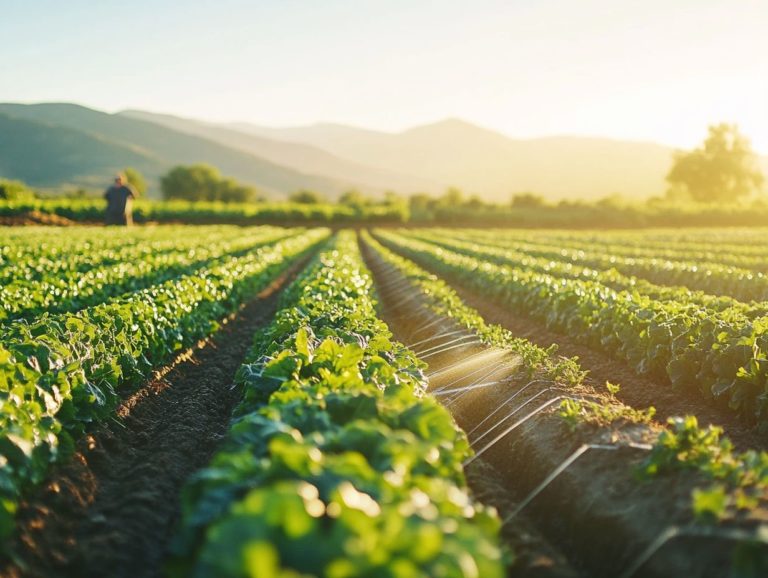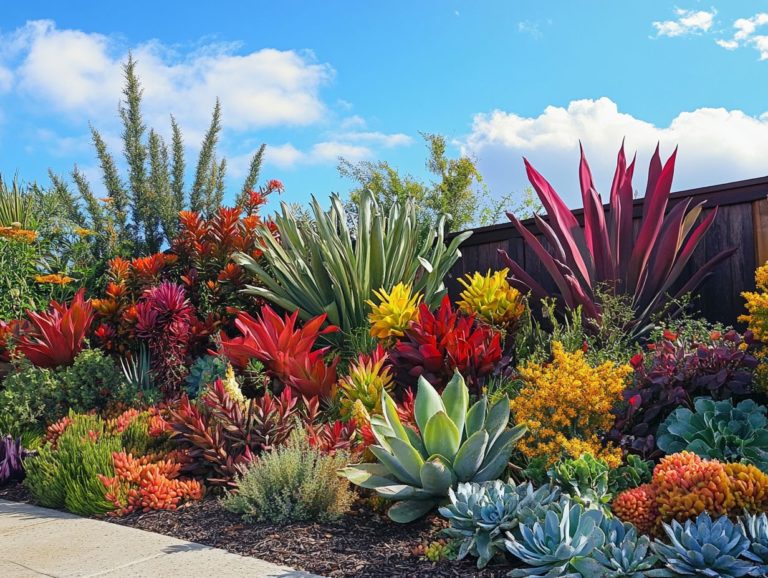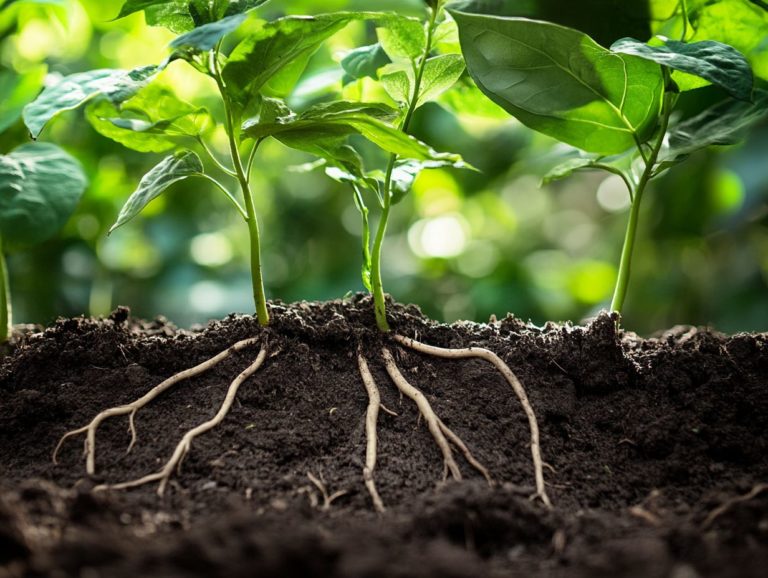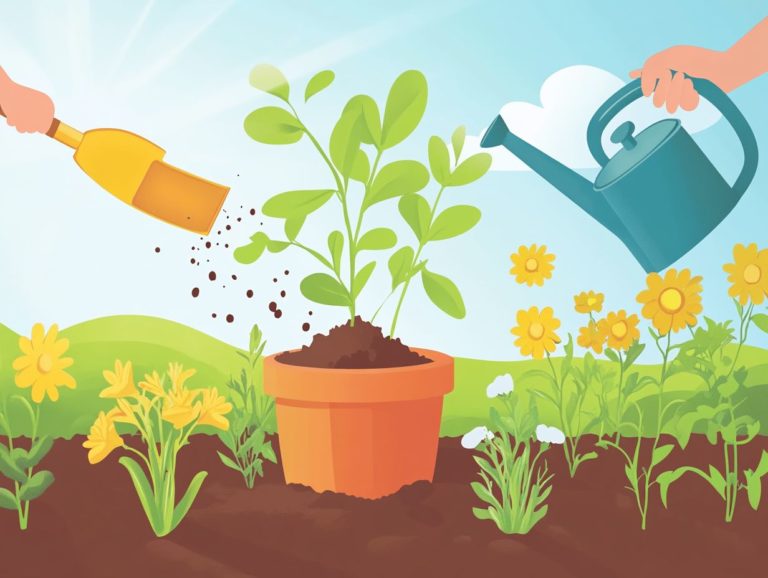How to Choose Plants for Drought Resistance
Drought resistance is becoming increasingly vital in our changing climate, where water scarcity poses significant threats to gardens and ecosystems.
This article covers key concepts about drought resistance, examining definitions, the factors that influence it, and the traits that empower plants to thrive under dry conditions.
You ll discover how to select the right drought-resistant plants, whether they re native or non-native. Plus, you’ll gain practical gardening techniques that will enhance your landscape s sustainability.
By the conclusion, you ll leave with practical tips to create your own beautiful drought-resistant garden.
Contents
- Key Takeaways:
- Understanding Drought Resistance
- Factors that Affect Drought Resistance
- Best Practices for Drought-Resistant Gardening
- Creating a Drought-Resistant Landscape
- Frequently Asked Questions
- What factors should I consider when choosing plants for drought resistance?
- Are all drought resistant plants the same?
- Can I only choose native plants for drought resistance?
- What types of plants are typically best for drought resistance?
- Can I still have a beautiful garden with drought resistant plants?
- Are there any maintenance tips for caring for drought resistant plants?
Key Takeaways:
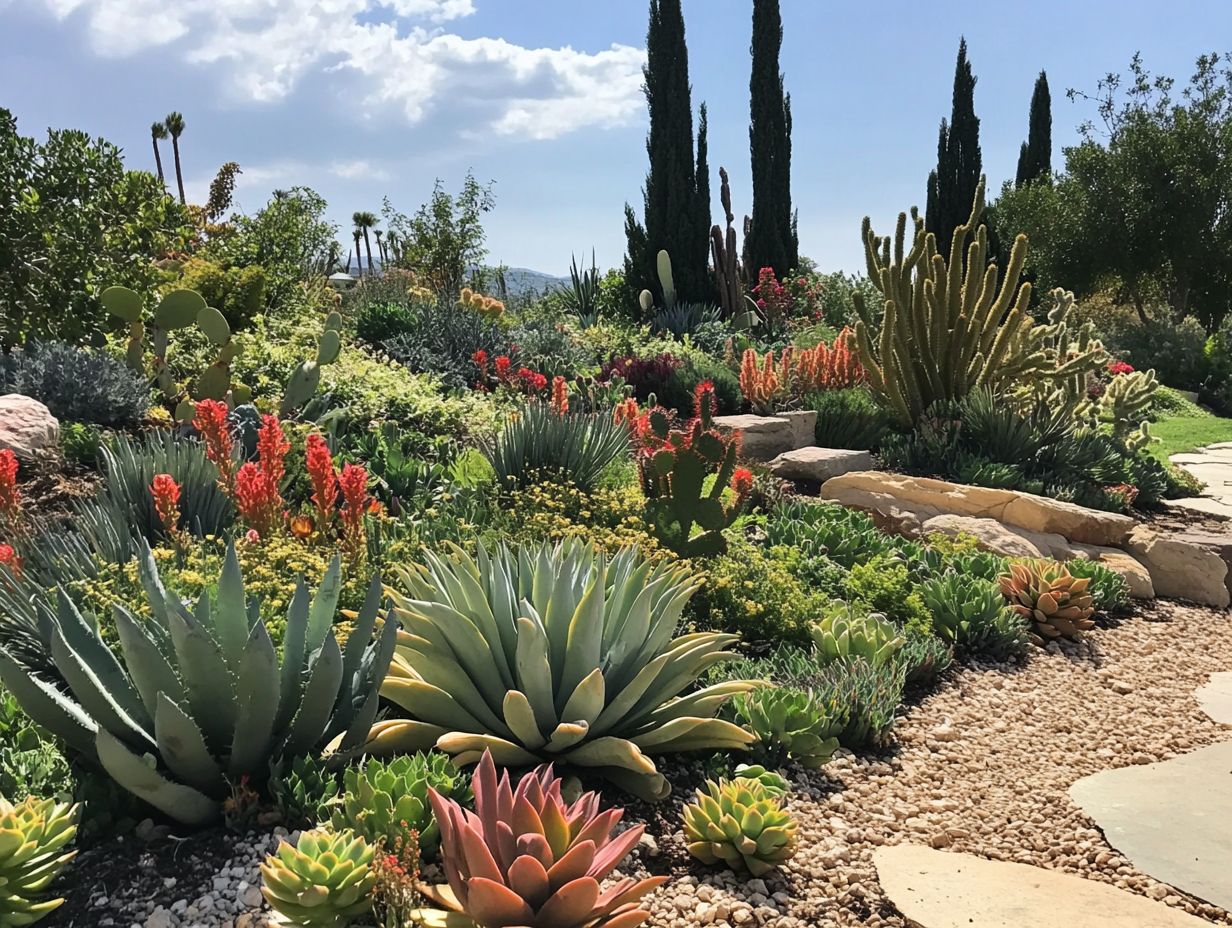
- Choose native species for better drought resistance. They are adapted to your local climate and soil conditions, making them more likely to thrive in dry conditions.
- Incorporate companion planting by planting drought-resistant plants alongside each other. This helps conserve water and creates a more resilient garden.
- Smart watering techniques and soil management are crucial for maintaining a drought-resistant garden. Utilize mulching and drip irrigation, a method that delivers water directly to the roots, to conserve water and keep plants healthy.
Understanding Drought Resistance
Understanding drought resistance is crucial for you as a gardener or landscape manager, especially for maintaining vibrant, low-maintenance gardens. Learning how to create a drought-resistant garden can help you thrive amid challenging drought conditions.
With environmental concerns on the rise, selecting the right plants that thrive in full sun and well-drained soil becomes paramount. Drought-tolerant plants, especially resilient perennials, offer a sustainable solution for achieving stunning blooms while minimizing water usage.
By emphasizing ecological gardening, you’ll ensure that your selections not only survive but actively contribute to local ecosystems, attracting vital pollinators and enhancing biodiversity.
Definition and Importance
Drought resistance is a plant’s ability to endure extended periods of low water availability, making identifying drought-resistant plant varieties essential for maintaining your garden during dry spells.
As climate change escalates the frequency of droughts, this trait becomes increasingly vital, prompting a shift toward more sustainable gardening practices. Choosing drought-tolerant plants helps you cultivate vibrant landscapes that require minimal irrigation, embracing ecological gardening.
These resilient species not only flourish in arid conditions but also play a crucial role in environmental sustainability by conserving water, reducing reliance on chemical fertilizers, and supporting local biodiversity.
By incorporating such plants, you can transform your traditional garden into a low-water oasis, enhancing both ecological health and your own gardening experience.
Factors that Affect Drought Resistance
Numerous factors significantly influence a plant’s resistance to drought, including soil type, climate conditions, and natural traits of plants. Understanding these elements is crucial for making informed plant selections, especially when learning how to design a drought-tolerant garden with flowering varieties that thrive in arid conditions.
Aspects like well-drained soil, full sun exposure, and the native adaptability of species can profoundly impact their resilience during water scarcity. By understanding how these factors interact, you empower yourself and other horticulture enthusiasts to cultivate sustainable and flourishing landscapes.
Soil Type and Climate
The type of soil and prevailing climate are essential factors that influence your plant’s ability to withstand drought conditions.
Well-drained soil is very useful. It allows excess water to flow away quickly, preventing waterlogging (too much water in the soil that suffocates roots) and ensuring that roots can access both air and moisture. This characteristic greatly enhances your plants’ health during dry spells since their roots can dive deeper for nutrients and hold onto moisture more effectively.
Different climates also play a significant role in this equation. For example, in arid environments, you’ll find plants that have adapted to thrive with minimal water and superior drainage capabilities. In contrast, humid climates can lead to denser, poorly-drained soils, which may worsen challenges during drought periods.
Understanding how soil characteristics interact with climate conditions is crucial for anyone serious about successful gardening and farming.
Choosing Plants for Drought Resistance
Understanding plant characteristics such as leaf structure, root depth, and water storage capabilities is essential for determining drought tolerance. These traits work together harmoniously, enabling drought-tolerant plants to thrive in arid conditions. For example, many resilient perennials develop deep root systems that can access underground moisture, while herbaceous plants often feature thick, waxy leaves that significantly reduce water loss through transpiration. Some species even have specialized storage tissues designed to retain moisture during extended dry spells.
By studying these adaptations, you can make informed choices when selecting plants, ultimately crafting resilient landscapes that not only survive but flourish amid challenging conditions.
Native Species vs. Non-Native Species
Selecting the right plants for drought resistance requires a thoughtful approach to understanding the advantages of native species over non-native varieties, ensuring your choices promote sustainable, low-water gardening. Native plants come equipped with natural adaptations that enable them to flourish in local drought conditions. By opting for these species, you’re not only minimizing water usage but also supporting local ecosystems and enhancing biodiversity in your garden. To learn more about choosing the right options, check out this guide on how to identify drought-resistant plants.
When considering drought resistance, native species often outperform non-native plants thanks to their natural adaptation to local climates and soil types. For those looking to learn more, understanding how to identify drought-resistant plants quickly can further enhance your gardening skills. This resilience enables them to thrive with minimal water resources, requiring less maintenance and care from you as a gardener or landscaper.
Native plants have evolved alongside local ecosystems, developing specific traits that allow them to conserve water, fend off pests, and endure harsh conditions. While non-native species may catch your eye with their aesthetic appeal, they often demand more water and chemical inputs for upkeep, which can harm the environment. By opting for native varieties, you boost biodiversity and nurture healthier habitats, making them a truly sustainable choice for drought-prone regions.
Adapting Existing Plants
Adapting your existing garden plants to withstand drought conditions is a smart tactic for enhancing your landscape’s resilience. You can cultivate a vibrant ecosystem that replenishes itself over time by incorporating drought-resistant plants and self-seeding strategies, ensuring a continuous display of greenery even during dry spells. Choosing low-maintenance varieties not only lightens your workload but also promotes sustainability, as these plants typically require less water and care.
Utilizing native species, renowned for their drought tolerance, can significantly boost your garden’s adaptability to changing weather patterns. Learn about companion planting and mulch application to enhance your garden’s success. These methods will help create a thriving environment even in the harshest climates.
Best Practices for Drought-Resistant Gardening
Implementing best practices for drought-resistant gardening requires you to embrace effective watering techniques, manage your soil thoughtfully, and explore innovative companion planting strategies. These methods are designed to conserve water while simultaneously enhancing the health of your plants.
Imagine a garden that thrives even in tough times! With the right plants, you can create a stunning space that stands up to drought. Learn how to get started with drought-resistant gardening today and make a difference for your local environment!
Watering Techniques and Soil Management
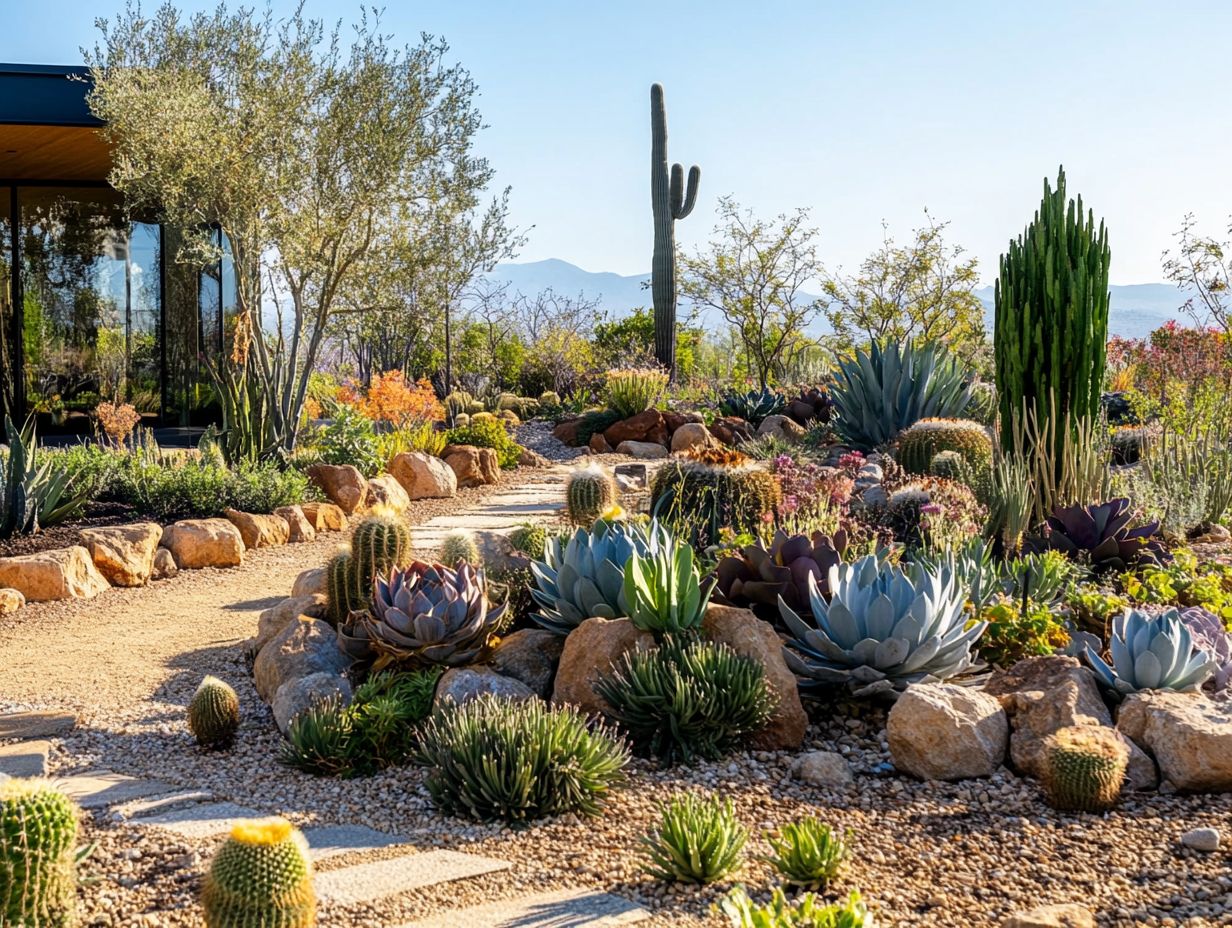
Effective watering techniques and proper soil management form the bedrock of gardening that helps plants survive dry conditions.
By selecting the right irrigation methods think drip irrigation, soaker hoses, or even rainwater harvesting systems you can use water better. Incorporating well-drained soil is crucial as it prevents waterlogging and ensures that your plants receive the moisture they need without drowning their roots.
This thoughtful approach conserves water resources and nurtures a healthier ecosystem where native plants can thrive.
By combining these practices, you can craft a sustainable landscape that requires less water while still flourishing. Low-water gardening becomes an achievable goal, allowing you to minimize your environmental footprint without sacrificing beauty or productivity.
Companion Planting for Drought Resistance
Companion planting is a powerful strategy for enhancing drought resistance by pairing drought-tolerant plants that support each other. This approach nurtures a more vibrant garden ecosystem.
Blending these plants cultivates a natural environment where they protect each other from pests and diseases. For example, planting legumes alongside drought-resistant herbs boosts nitrogen levels in the soil while helping retain moisture, enhancing overall growth.
This relationship conserves water and reduces reliance on chemical fertilizers, forming a cornerstone of ecological gardening. Understanding these connections can elevate your garden into a resilient and flourishing sanctuary, even amid challenging climates.
Creating a Drought-Resistant Landscape
Creating a drought-resistant landscape demands a meticulous design that integrates the best drought-resistant plants, cultivating an environment that flourishes with minimal water input. This thoughtful planning enhances the beauty of your outdoor space and promotes sustainability, making your landscape resilient and resource-efficient.
Designing with Drought-Resistant Plants
Designing your garden with drought-resistant plants elevates its aesthetic appeal and champions sustainability through thoughtful landscape management.
Incorporating native flora into your design creates an environment that thrives on minimal water needs. This approach conserves resources and supports local wildlife by providing crucial habitats for pollinators and other beneficial organisms.
Choosing plants that adapt well to your local climate and soil conditions means less maintenance and greater resilience against pests and diseases. You can create a vibrant, low-maintenance space while enhancing the ecosystem.
This careful selection of plants showcases your commitment to protecting the environment and encourages sustainable gardening practices that resonate with nature.
Long-Term Maintenance Strategies
Long-term maintenance strategies for your drought-tolerant garden should prioritize minimizing water use while ensuring your plants continue to thrive.
Selecting native and resilient plant species naturally requiring less water is key. Implementing techniques like mulching helps conserve moisture in the soil, keeping your garden hydrated.
Consider using drip irrigation systems for targeted watering; this approach reduces wastage and encourages deep root growth.
Regularly checking the soil’s health and organic matter significantly enhances your garden’s resilience, creating an environment where your plants flourish with minimal intervention. Embracing these low-maintenance practices cultivates a sustainable garden that supports biodiversity and respects the importance of water conservation.
Frequently Asked Questions
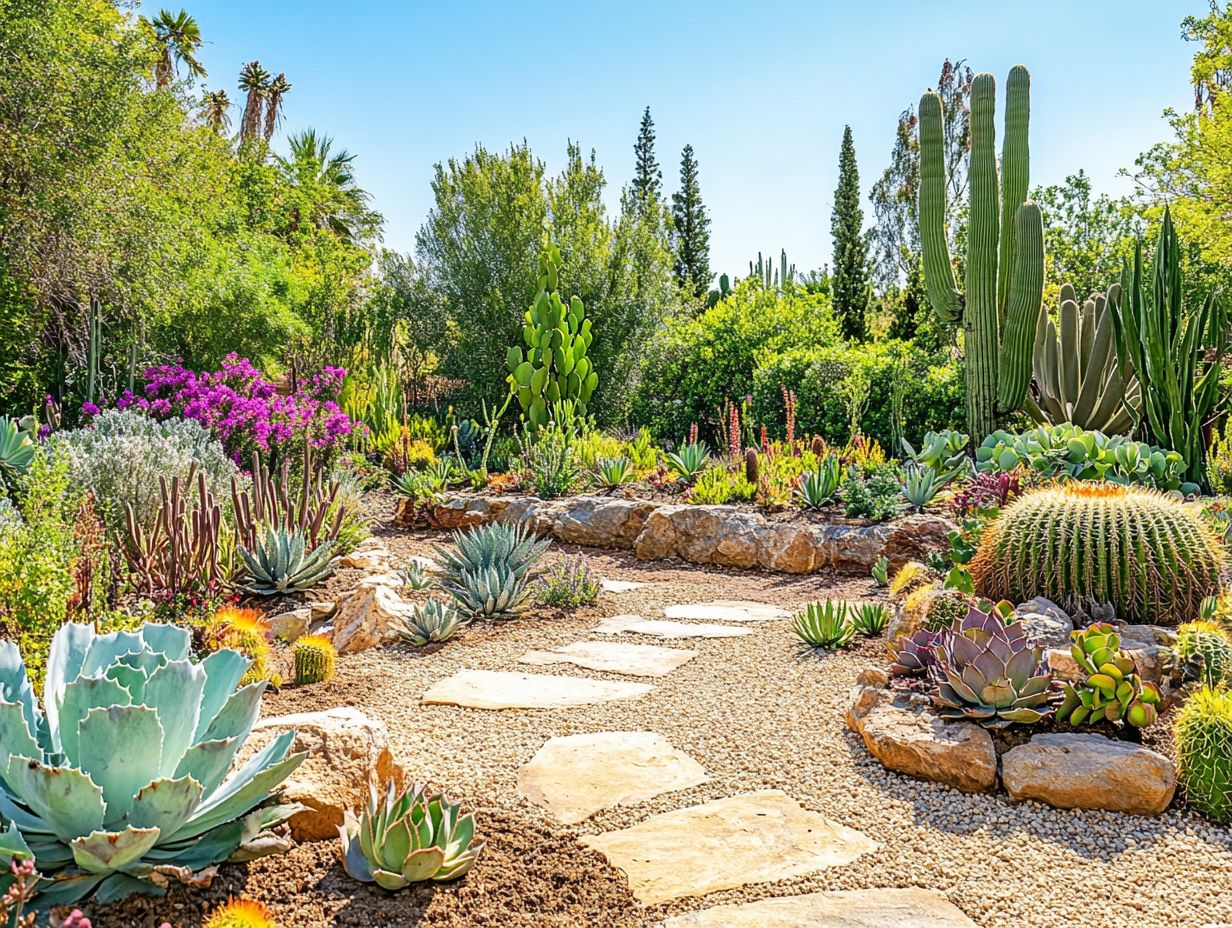
Start your journey towards a thriving, low-water garden today!
What factors should I consider when choosing plants for drought resistance?
Choose plants based on your local climate and soil conditions. Also, consider how much water is naturally available in your area.
Are all drought resistant plants the same?
No, not all drought resistant plants are the same. Some thrive in dry conditions, while others are carefully chosen and grown to resist drought.
Can I only choose native plants for drought resistance?
While native plants are often great choices, you can also pick non-native plants. Many of these can thrive in dry conditions too!
What types of plants are typically best for drought resistance?
Succulents and cacti are excellent choices. They store water in their leaves and stems, helping them survive in dry areas.
Can I still have a beautiful garden with drought resistant plants?
Absolutely! Many drought resistant plants have vibrant colors and unique textures. You can also add rocks and mulch for extra visual appeal!
Are there any maintenance tips for caring for drought resistant plants?
Yes! Water new plants until they are settled. After that, they may just need occasional watering during dry spells.
Adding mulch around them helps keep moisture in, and check regularly for any pests or diseases.

